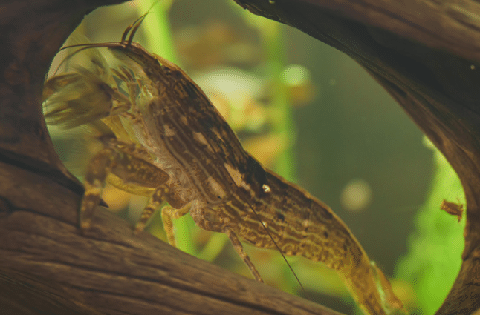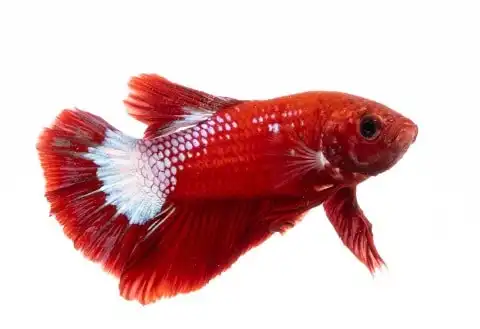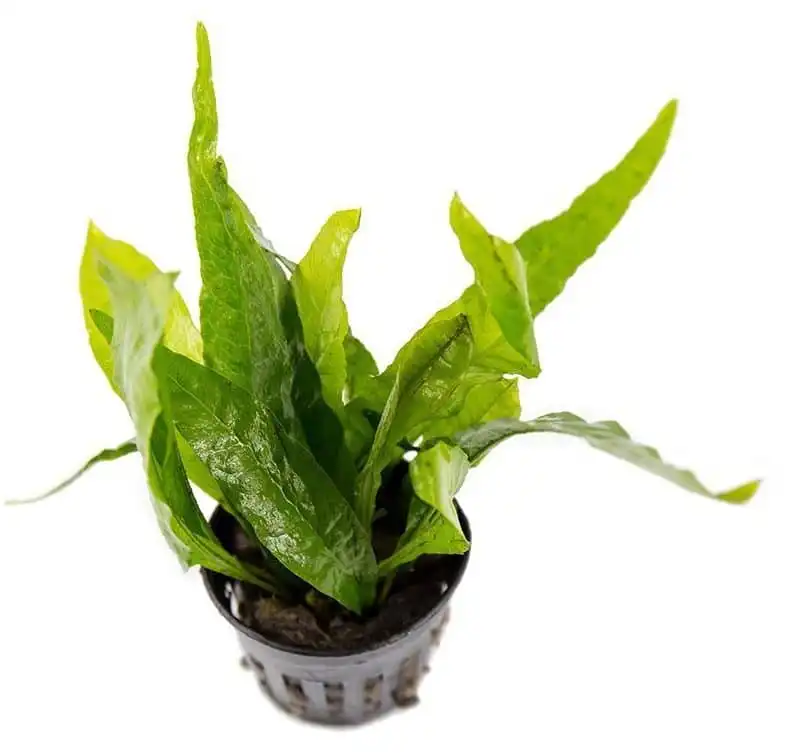Thank you for visiting! By the way… any links on this page that lead to products on Amazon and other stores/partners are affiliate links Aquarium Store Depot earns a commission if you make a purchase.
Freshwater fish get all the attention. But have you ever set up a tank filled with fish and felt like something was still missing from the display? Like there wasn’t enough movement or color on the bottom of the tank? This is where shrimp come in!
The freshwater hobby has many different shrimp species to choose from. One of these is the bamboo shrimp which is simple in appearance but a unique and efficient algae controller.
Key Takeaways
- Bamboo shrimp are an interesting freshwater species of filter-feeding shrimp.
- These shrimp have simple aquarium requirements but can be sensitive when being transported.
- Bamboo shrimp are very difficult to breed in captivity and have a short lifespan. They are reasonably more expensive than most other species available.
Species Overview
| Scientific Name | Atyopsis moluccensis |
| Common Names | Bamboo shrimp, wood shrimp, Moluccas shrimp, Singapore flower shrimp, Singapore shrimp |
| Family | Atyidae |
| Origin | Native to Southeast Asia |
| Diet | Omnivore |
| Care Level | Easy |
| Activity | Moderate |
| Lifespan | 1 to 3 years |
| Temperament | Peaceful fish |
| Tank Level | Middle and bottom |
| Minimum Tank Size | 20 gallons |
| Temperature Range | 68 – 85 °F |
| Water Hardness | 3 – 10 KH |
| pH Range | 6.5 – 8.0 |
| Filtration/Water Flow | Moderate to high |
| Water Type | Freshwater |
| Breeding | Egg Layer |
| Difficulty to Breed | Very difficul |
| Compatibility | Community |
| OK, for Planted Tanks? | Yes |
Introduction
Many hobbyists adore saltwater aquariums for their bright and colorful fish. But have you ever seen a freshwater tank filled with vibrant and active shrimp? The freshwater hobby is filled with different shrimp species that are easy and rewarding to keep.
One of the most popular species of freshwater shrimp to keep is the bamboo shrimp, also commonly known as the Singapore shrimp or wood shrimp. Scientifically, the bamboo shrimp is known as Atyopsis moluccensis. Unlike other popular species of freshwater shrimp, the bamboo shrimp is not a dwarf species in itself, though a dwarf relative has been discovered: Atyopsis spinipes1.
Bamboo shrimp are great shrimp to keep in the freshwater aquarium. They get along with almost every fish, are relatively hardy, and help keep the tank clean. They aren’t the most colorful species of freshwater shrimp available, though, which can make some hobbyists look past them.
Origin
It might be hard to believe, but bamboo shrimp originate from areas where bamboo naturally grows. This is largely throughout Southeast Asia, including parts of Thailand, Indonesia, Sri Lanka, and the Philippines.
There, these shrimp feed on plant and animal particles in the water column as well as in the substrate. Interestingly this is an Asian filter-feeding shrimp. This means that these shrimp have specially adapted claspers with a feathery, fan-like appearance. This allows them to stand in a moderate to strong water current with their fans pointed outwards to catch anything that passes by.
Because they’re filter feeders, they are found in a warm, fast-moving natural habitat that is full of debris and other organic material.
Appearance
Bamboo shrimp aka flower shrimp aren’t the most colorful shrimp. There’s a reason why they’re also known as wood shrimp.

Bamboo shrimp are one of the largest freshwater aquarium shrimp available, growing to about 2 to 4 inches. They are bulky shrimp with large, rounded bodies. As fan shrimp, they have two pairs of feathery arms that help them pull food particles out of the water.
These shrimp are typically brownish-red but can become darker or lighter depending on available food and other environmental factors. Upon closer inspection, you can see many thin, dark pinstripes run along the sides of their body. Down the middle of their body is a thick off-white stripe that runs from their antennae to the base of their tails.
Male vs. Female
Bamboo shrimp are pretty costly. Considering that they only live for a couple of years, it can be expensive to replace your colony so often. Because of this, many shrimp keepers try breeding bamboo shrimp, though we’ll find out that this is a challenge in itself.
To breed bamboo shrimp, you need to have a male and female individual. These shrimp are relatively easy to tell apart from each other, but only when they’re mature in size.
Like other shrimp and crustaceans, you need to look at the abdomen of the shrimp. Female shrimp carry eggs in and around their pleopods, or swimming legs, underneath their abdomen, so this area needs to be big.
In general, males are larger than females. Males also have bigger, thicker first walking legs. From above, male bamboo shrimp are slimmer and shorter than females. Females have wider and longer abdomens, as well as longer pleopods.
Temperament and Behavior
Bamboo shrimp are perfect tank mates for a community tank setup. Their larger size also makes them compatible with some of the bigger tropical fish species available as long as temperaments match.
Despite their large size, they can be shy with sudden movements and bright lights. It may take several weeks for a new shrimp to acclimate to its new home, so make sure to add plenty of hiding spots in the beginning.
In general, this fan shrimp can safely be kept with all community fish species. They spend most of their time propped up on plant leaves or other aquarium decorations in the water current with their fans extended. If your fan shrimp is traveling to the bottom of the tank to look for food in the substrate, then this could indicate that there isn’t enough available food in the water column.
While a healthy bamboo shrimp may still display this behavior, it’s strongly recommended to start offering more available foods that make feeding easier.
Bamboo Shrimp Tank Mates
Not too many hobbyists have a shrimp tank that only features bamboo shrimp. This shrimp species is often an afterthought to a community tank featuring other tropical fish and invertebrates. Luckily, they fit in with almost every tank mate combination!
How Many Should Be Kept Together?
Bamboo shrimp are not territorial towards each other or other shrimp. That being said, there are a few limiting factors that can stop you from keeping multiple bamboo shrimp together.
First, space can become an issue. Not for the reason you may think, though. Instead, bamboo shrimp are very efficient filter feeders that can clean available food particles out of the water column within a few days. This can lead to a shortage of food when there is too much competition.
Second, bamboo shrimp are large shrimp. Though they’re not aggressive, they can add additional bioload to the aquarium that can add up over time.
In general, as long as your shrimp are easily able to find food and have good filtration, then you can keep as many as you would like together.
Best Tank Mates For Them
But what other shrimp and fish can you keep with your bamboo shrimp? Almost everything!
The good news is that bamboo shrimp are large freshwater shrimp. Most tropical fish have small mouths, which takes bamboo shrimp off the menu. This makes bamboo shrimp a great choice for a betta tank, though you will need to create some areas of higher flow in the aquarium that your betta might not appreciate!
Use Coupon Code ASDFISH at Checkout
Betta Fish are one of the most beautiful varieties of freshwater fish available in the hobby. Easy to care for with plenty of varieties!
These shrimp keep to themselves in the aquarium and won’t bother other peaceful fish. Because they usually perch on live plants and other decorations, they also stay out of the way of bottomfeeders and other active species. Some of the best tank mates for bamboo shrimp are:
Can They Live With Other Shrimp?
Yes! Bamboo shrimp can live with other freshwater shrimp, specifically dwarf shrimp species. Because these shrimp aren’t the most colorful on their own, many hobbyists keep them with cherry shrimp (Neocaridina davidi) and vampire shrimp (Atya gabonensis). Other less colorful tank mates include Amano shrimp (Caridina multidentata) and ghost shrimp (Palaemonetes paludosus).
Least Compatible Fish For Them
Although large shrimp, bamboo shrimp are still an appetizing choice for fish with large mouths. Fish that should be avoid are:
- Cichlids (including angelfish)
- Goldfish
- Territorial aggressive fish
It should also be noted that bamboo shrimp should not be kept with crayfish, like the Mexican dwarf crayfish (Cambarellus patzcuarensis). Even though these two invertebrates might look similar to one another, the crayfish will gladly eat your shrimp.
Care
Bamboo shrimp care is easy, but there are a few ways you can guarantee the success of your shrimp. Keep in mind that these shrimp only live a couple of years on average, so you want to make the most of it! They are also much more expensive than other shrimp in the aquarium trade.
Are They Hard To Keep?
Bamboo shrimp aren’t one of the hardiest shrimp varieties available. They are susceptible to incorrect or fluctuating water parameters, which can make transferring them between different freshwater aquariums difficult. Your shrimp is most likely to die within the first few days of having it in your tank.
To prevent this from happening, it’s strongly recommended to use a quarantine system that gives full control over tank conditions. Purchase from a reputable seller that keeps juvenile shrimp so that you get the most time with your new invertebrate.
Tank Requirements
The best bamboo shrimp care will stem from a good aquarium setup. These shrimp need a mature aquarium where they can feed on the fine particles and microorganisms already present in the water column.
A new tank setup is too clean and will need to be heavily fed to sustain your shrimp.
Tank Size
You’ve most likely seen a small tank filled with cherry shrimp at your local fish store. Since bamboo shrimp are similar to other shrimp species, does this mean that they can be kept in a small tank too?
No. Bamboo shrimp prefer a larger tank setup for a few reasons.
First, bamboo shrimp are large shrimp. While they don’t move around the tank much, they create significantly more bioload than small shrimp. They may also struggle to be present in the tank if there are too many other shrimp occupying the space.
Another reason why bamboo shrimp need a larger tank is that they heavily depend on their natural habitat for food. These shrimp need plenty of available food in the water column for their success. A small tank has much less available food, which can cause your shrimp to quickly run out of things to eat.
How Many Can You Put In A 55 Gallon Tank?
There are a lot of factors that go into determining how many bamboo shrimp you can have in your tank. In theory, a 55 gallon could hold a lot of shrimp! But this probably isn’t the best option.
Consider how much natural food is available in your aquarium. Is there a constant supply of plant debris? How often do you feed your fish? Are your shrimp competing for the same food as other fish or invertebrates?
There are some questions you should be asking yourself before you introduce multiple bamboo shrimp into your aquarium. That being said, it’s recommended to keep 1 bamboo shrimp per every 20 gallons of water. This would mean that about 2 to 3 bamboo shrimp could comfortably be kept in a 55 gallon aquarium.
Setup
Aquarium setup doesn’t matter too much when keeping bamboo shrimp as they’ll find their niche within the system. However, there are a few ways you can optimize your shrimp’s way of living.
One of the most important aspects of keeping bamboo shrimp is making sure that there is some water current moving throughout the aquarium. These shrimp come from naturally fast-moving waters where they stand in the current to filter food. Some hobbyists use their filter return or a powerhead to create a stream of water current specifically for their shrimp.
A powerhead pairs well with a sponge filter. This combination allows for water flow as well as a bioload station for bamboo shrimp to pick at if they don’t feel like catching their food.
Otherwise, bamboo shrimp do not need any special aquarium setup. Some hobbyists prefer to dim their lighting or use tannins to create a more comfortable environment for these shy shrimp.
Decor
Bamboo shrimp do best in a heavily planted aquarium where there are plenty of organics available in the water. This can be a high or low tech setup with varying lighting intensities; as mentioned before, bamboo shrimp tend to be more present in dimmer lighting.
Editor's Choice
Manzanita offers it all. Great shape, low tannins, quick to water log and reasonably priced. It's the ultimate driftwood!
These shrimp will appreciate natural decor in the form of driftwood, smooth rocks, and leaf litter. However, they can also be kept in more artificial setups as well.
Substrate
The type of substrate you keep your bamboo shrimp on doesn’t matter too much. These shrimp usually stay off the substrate, staying perched on driftwood and aquarium plants.
For the most natural tank setup, a light or dark brown substrate is recommended.
Live Plants
Bamboo shrimp will greatly appreciate an assortment of live plants. These shrimp will make their home in dense vegetation, catching any food that happens to pass by. Plant matter will also enter the water column, providing additional food for your shrimp.
Java Fern is one of the easiest and hardiest live plants you can purchase
These do not need to be difficult plant species as the coverage will be appreciated nonetheless. Some of the best plant species include:
- Anubias spp.
- Cryptocoryne spp.
- Java fern (Leptochilus pteropus)
- Hornwort (Ceratophyllum demersum)
- Java moss (Vesicularia dubyana)
Keep in mind that a densely planted aquarium might require dosing plant fertilizers if not enough nutrients are readily available for growth.
Editor's Choice
Made by an aquascaper for aquascapers. This is the best all around aquarium plant fertilizer on the market. Marco and micronutrients in one bottle!
Use Coupon Code ASDComplete for 10% off your order!
Water Quality And Filtration
Bamboo shrimp are relatively hardy shrimp but they still require mature tank conditions. Good filtration and water circulation are necessary for keeping a happy and healthy bamboo shrimp.
Filtration & Aeration
As mentioned before, bamboo shrimp will do best with a sponge filter in combination with a powerhead. This creates an area for grazing around the filter while also making a current that your shrimp can stand in.
For larger tanks, a hang on the back filter or canister filter is recommended for better filtration and water movement. A powerhead may still be necessary to create areas of higher flow for your shrimp.
Our Subscriber's Choice
Top name brand, Italian made, and updated design. The next gen Fluval Canisters are a best buy!
An air stone is not necessary, though can help circulate water and nutrients.
Water Parameters
Bamboo shrimp are sensitive to imperfect water parameters. They cannot tolerate any traces of ammonia or nitrite and start to have trouble when nitrates exceed 20 ppm. They can be kept in a wide water temperature range between 68 and 85° F but prefer relatively neutral pH levels between 6.5 and 8.0.
One of the more important water parameters to be aware of is calcium. Freshwater shrimp go through the molting process about every month and a half. This is when they shed their old exoskeleton to grow.
To grow a new shell, they need plenty of calcium available in the water. While this is usually brought in through water changes and diet, bamboo shrimp may be given special shrimp calcium blocks from time to time.
Aquarium Maintenance
Aquarium maintenance for bamboo shrimp is straightforward, especially in a mature tank where parameters are stable. In general, a 10-25% weekly or biweekly water change is recommended for a moderately stocked freshwater aquarium. Bamboo shrimp prefer slightly ‘dirtier’ conditions where food is available in the water column, so some hobbyists only do water changes every other week or once a month.
When performing a water change, make sure to use an aquarium vacuum to remove any rotting food or plant matter.
Testing Tank Conditions
To ensure that your tank is always running the best that it can, regularly test your aquarium water with a dependable test kit. This test kit should use liquid reagants as testing strips are highly inaccurate.
Calcium should also be tested with a test kit.
Food And Diet
While most shrimp can be maintained through only the leftover fish food in the aquarium, bamboo shrimp require some special care and attention when it comes to their food and diet.
Don’t worry, though! Bamboo shrimp feeding doesn’t require too much extra time.
If you notice that your shrimp is searching around sponge filters or wandering around the substrate, there might be a lack of food. At this point, it’s strongly recommended to supplement feedings.
Powdered food, crushed fish food, broken-up algae wafers, and small live food may be given daily.
Bamboo shrimp will not fix an algae problem, meaning that they won’t graze on available algae. Instead, they’ll help purify the water of any microscopic waste or organisms that could lead to an algae bloom.
Breeding
Breeding bamboo shrimp is rarely done in the aquarium hobby. Like Amano shrimp, bamboo shrimp need brackish water during their larval stages.
To go about breeding bamboo shrimp, you need a male and a female. Once successfully bred, the fertilized eggs must be gently detached from the female and moved to brackish water conditions. From there, the fry may be fed spirulina powder until they mature.
Where To Buy
Bamboo shrimp are pretty expensive. Their sensitivity to stresses during transportation also makes them slightly difficult to come across at your average pet store. Because they’re difficult to breed in captivity, they also can’t be sourced from fellow hobbyists.
Instead, these shrimp can be purchased online or from more specialized retailers.
Conclusion
In conclusion, bamboo shrimp are one of the more forgotten species of shrimp available. These are filter feeding shrimp that need a good source of food in a mature aquarium setup. They are slightly sensitive to changes in environment and water conditions and have short lifespans.
Still, they’re great invertebrates to have for controlling excess waste and potential algae blooms!
- About the Author
- Latest Posts
I’m thrilled that you found Aquarium Store Depot! Here you’ll find information on fish, aquariums, and all things aquatics related. I’m a hobbyist (being doing this since I was 11) and here to help other hobbyists thrive with their aquariums! I adhere to a high quality Editorial Process and Review products with real life field usage and practical analysis.










